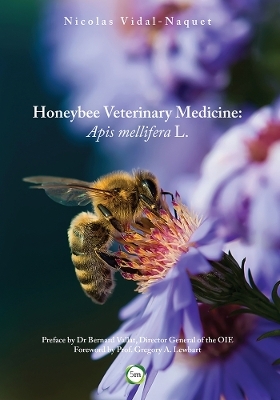
Honeybee Veterinary Medicine
5m Publishing (Verlag)
978-1-910455-04-3 (ISBN)
Honeybees are an essential part of farming and the wider ecosystem. Since the middle of the 1990s bee populations around the world have suffered dramatic decline through diseases, intoxication, and unknown causes. Veterinarians have had little training in bee health but as the situation continues, qualified animal health professionals and, in particular, veterinarians are being required to become involved as new dangers threaten honeybee health everywhere because of global apiculture trade and exchanges of honeybees, products of the hive and beekeeping material such as Aethina tumida (the small hive beetle - a beekeeping pest) introduced in Italy in 2014 or the mite Tropilaelaps spp (parasitic mites of honeybees).
This book will provide an overview of bee biology, the bee in the wider environment, intoxication, bee diseases, bee parasites (with a large part dedicated to the mite Varroa destructor) pests, enemies, and veterinary treatment and actions relating to honeybee health. The book will also cover current topics such as climate change, crop pollination, use of phytosanitary products, antibiotic resistance, and Colony Collapse Disorder.
While aimed at veterinary practitioners, students and veterinarians involved in apiculture and bee health (officials, researchers, laboratory veterinarians, biologists...), the book can also be beneficial to beekeepers, beekeeping stakeholders, animal health and environmental organisations.
Nicolas Vidal-Naquet, DVM, graduated in apiculture and Honeybee medicine, is a veterinary practitioner and lecturer in Honeybee biology and diseases at the Veterinary School of Alfort, France.
Introduction
Chapter I. Biology of Apis mellifera L: from the individual to the super-organism
- Taxonomy and natural history
- The colony: definition and characteristics
- The castes: morphology
- Digestive tract and metabolism in honeybee Apis mellifera L.
- Respiratory and circulatory systems
- Immune system and mechanism of protection and defence in Honeybee Apis mellifera L. (at the individual and colony levels)
- Temperature regulation
- Nervous system
- The nest structure
- Reproduction: drones, queen and brood development
- Nutrition
- Organization and communication within the colony
- Swarming and supersedure : division of the colony and replacement of the queen
- Colony life cycle
Chapter II. Environmental troubles and intoxications
- Meteorological and climate influence on colony welfare and health
- Influence of food resources on colony welfare and health
- Intoxications
Chapter III. Honeybee viruses and viral diseases
- Generalities on Honeybee viruses
- Chronic Bee Paralysis Virus (CBPV) disease: “paralysis”
- Deformed Wing Virus (DWV) disease
- Sacbrood Virus (SBV) disease
- Slow Bee Paralysis Virus (SBPV)
- Dicistroviruses diseases
- Other viruses of the Honeybee colonies
Chapter IV. Honeybee bacterial diseases
- American Foulbrood disease
- European Foulbrood disease
- Other bacterial diseases
Chapter V. Parasitic diseases
- Varrosis, the infestation by the mite Varroa destructor
- Tracheal acariosis, the infestation by the mite Acarapis woodi
- Tropilaelosis, the infestation by the mites Tropilaelaps clareae and Tropilaelaps mercedesae
- The infestation by the fly Braula coeca
Chapter VI. Fungal and protozoan diseases
- Chalkbrood disease: Ascosphaera apis
- Stonebrood disease: Aspergillus spp.
- Nosemosis: Nosema apis and Nosema ceranae
- Amoebosis of Malphigian tubules : Malpighamoeba mellificae
Chapter VII. Pests and enemies of Honeybee colonies
- Galleria mellonella, the Greater Wax Moth
- Achroia grisella, the Lesser Wax moth
- Aethina tumida, the Small Hive Beetle
- Vespa velutina, the Asian Hornet
- Other pests and enemies of the hives
Conclusion of the environmental and chemical-induced troubles, diseases and pests chapters. The Colony Collapse disorder (CCD): one reality, several causes?
Chapter VIII. Good Sanitary Beekeeping practices
- About the HACCP principles
- Hazards in beekeeping
- General Honeybee farm management
- Honeybee colonies management
- Veterinary Medicine Products
- Honeybee colonies feeding supplementation
- Hives, apiaries and environment
- Handling of honeybee colonies and products of the hive
- Sanitary generalities on honey extraction and production
Chapter IX. Honeybee veterinary medicine and practice
- Clinical examination of colonies and elements of semiology
- Sanitary audit of husbandry in apiculture
Appendix 1. Table: Average values and characteristics of honeybee colonies and values for brood and adult population evaluation
Appendix 2. Table: Notifiable diseases to the OIE and to European countries
Appendix 3. Table: Methods of sampling
Appendix 4. Table: Practical method for a sanitary audit of an apiary
Appendix 5. Council Directive 2001/110/EC of 20 December 2001 relating to honey
| Vorwort | Dr. Bernard Vallat, Prof. Gregory A. Lewbart |
|---|---|
| Zusatzinfo | Colour |
| Verlagsort | Sheffield |
| Sprache | englisch |
| Maße | 170 x 240 mm |
| Gewicht | 367 g |
| Themenwelt | Naturwissenschaften ► Biologie ► Zoologie |
| Veterinärmedizin | |
| Weitere Fachgebiete ► Land- / Forstwirtschaft / Fischerei | |
| ISBN-10 | 1-910455-04-0 / 1910455040 |
| ISBN-13 | 978-1-910455-04-3 / 9781910455043 |
| Zustand | Neuware |
| Haben Sie eine Frage zum Produkt? |
aus dem Bereich


